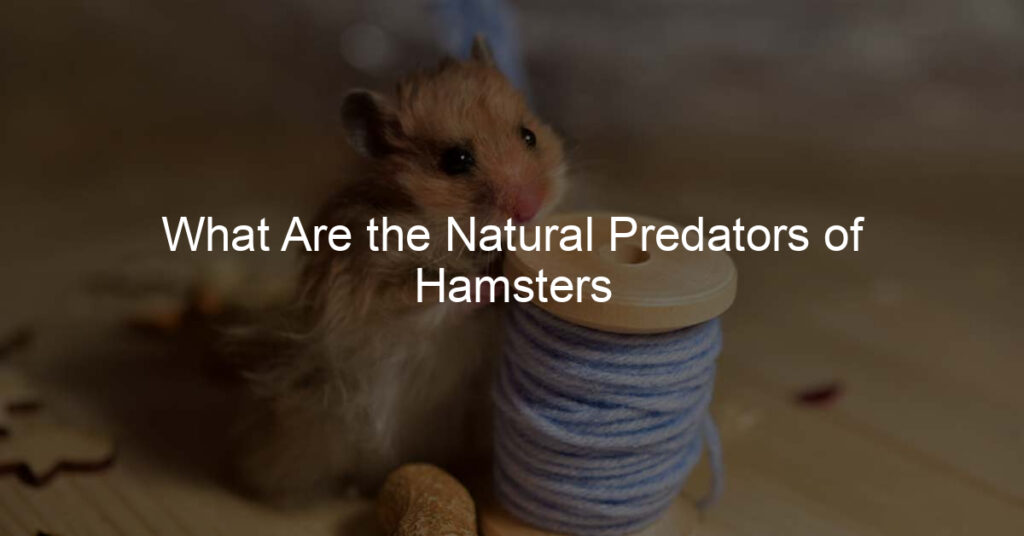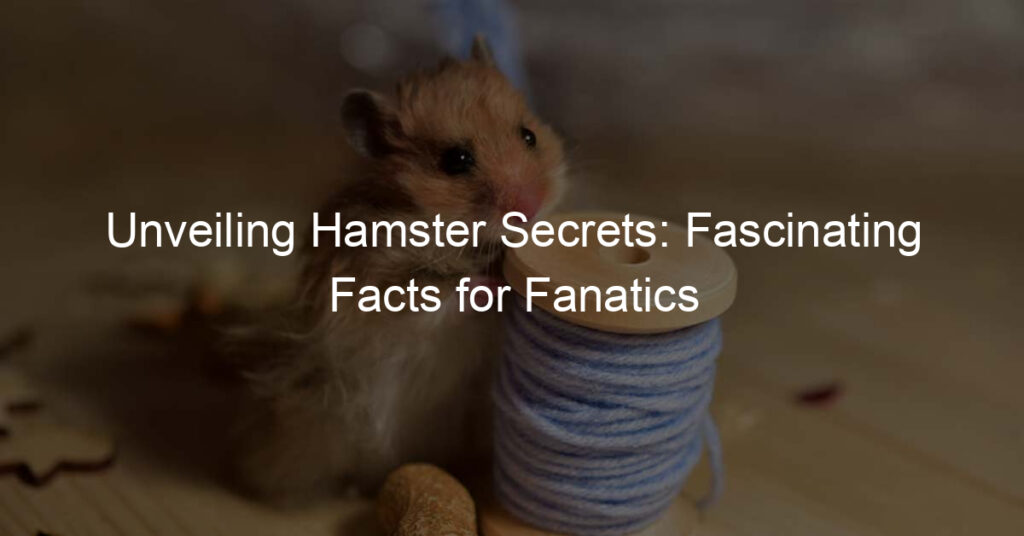Hamsters are small, furry rodents that belong to the subfamily Cricetinae, within the family Cricetidae.
These charming creatures originated in northern China and have become popular pets around the world. However, in the wild, a variety of natural predators of hamsters threaten their survival.
There are several types of hamsters, including wild hamsters and those that have been domesticated.
Regardless of their variety, all hamsters share certain characteristics and behaviors that evolved as survival strategies to help them evade their predators.
In the natural habitats of hamsters, these predators are primarily nocturnal animals, just like hamsters themselves.
Understanding the relationship between hamsters and their predators can provide insight into these small animals’ unique adaptations and behaviors.
It also helps pet owners ensure the safety of their hamsters in domestic environments by knowing how to protect them from potential dangers.
Key Takeaways
- Hamsters are small rodents originating from northern China, facing various predators in the wild.
- Wild and domesticated hamsters share similar characteristics aiding in their survival against predators.
- Nocturnal animals are the primary predators of hamsters in their natural habitats.
Hamster Types
Hamsters are small and cute rodents that are popular as pets and come in a variety of breeds. In this section, we will discuss three types of hamsters: Northern Chinese Hamsters, Golden Hamsters, and Mongolian Dwarf Hamsters.
Northern Chinese Hamsters
The Northern Chinese Hamster (Cricetulus kamensis) is a small rodent that is native to China and Mongolia. These hamsters have a slim body and resemble a mouse or a rat. They can grow up to 12 centimeters in length and have sleek, grey, or brown fur.
They are also known as the striped dwarf or Chinese dwarf hamster and are sometimes confused with the Roborovski hamster, but they possess unique physical features that set them apart from other dwarf hamsters.
Northern Chinese Hamsters are nocturnal creatures, meaning that they are mostly active during the night. They enjoy exploring and burrowing, making them suitable pets for those who appreciate an active and engaging companion.
Golden Hamsters
The Golden Hamster (Mesocricetus auratus), also known as the Syrian Hamster, is a popular choice for a pet. They are larger than dwarf hamsters, with an average size of up to 18 centimeters in length.
They have a thick fur coat that comes in various colors, such as golden, brown, or white, as well as patterns, such as banded or spotted.
Golden Hamsters are solitary animals, which means they generally prefer to live alone. They can be territorial and might not get along with other hamsters.
It is crucial to provide them with adequate space, toys, and activities to keep them entertained and engaged as they are active and energetic creatures.
Mongolian Dwarf Hamster
The Mongolian Dwarf Hamster (Allocricetulus curtatus) is a small rodent that can be found in Mongolia and some parts of China. They can grow up to 10 centimeters in length and have sandy brown fur with a white belly, making them visually appealing as pets.
Mongolian Dwarf Hamsters display friendly behavior, and with proper handling and socialization, they can become good pets for those who prefer a smaller breed.
Like other hamsters, they are nocturnal and require an environment that meets their unique needs, such as quiet surroundings and a consistent day-night cycle.
Each of these hamster types offers different qualities that can cater to various preferences of pet owners.
Northern Chinese Hamsters are slim and active, Golden Hamsters are well-known for their beautiful fur coats and energetic nature, and Mongolian Dwarf Hamsters possess a friendly temperament while being a smaller breed.
Habitats of Hamsters
Hamsters are small, adorable creatures that many people know as household pets. However, these little animals also exist in the natural world, inhabiting various habitats in different regions.
Primarily found in the Middle East, Asia, and some parts of Eastern Europe, hamsters thrive in warm and dry environments.
One of the most well-known species of hamsters, the Syrian Hamster, is native to the deserts of Syria. These hamsters prefer warm, sandy environments where they can build their burrows.
Burrows are essential for hamsters as they provide shelter, protection from predators, and a place to store food.
In Asia, hamsters such as the Roborovski and Dwarf hamsters can be found in regions spanning from China to Mongolia and Siberia. These areas, while still characterized by a dry climate, tend to have varying temperatures that hamsters can adapt to.
Despite these different environments, hamsters still maintain their preference for burrows as their primary shelter.
Deserts and semi-arid regions in the Middle East are also home to various hamster species. Some hamsters thrive in this natural habitat, making use of the limited vegetation, particularly for camouflage and sustenance.
Hamsters can be found in various habitats, primarily in warm and dry regions across the Middle East, Asia, and Eastern Europe. Their natural environments involve different landscapes such as deserts, semi-arid regions, and even areas with temperature fluctuations like Siberia.
Regardless of their specific habitat, hamsters always rely on burrows for shelter and safety, making them a crucial aspect of their survival in the wild.
Hamster Characteristics
Hamsters are small, furry mammals that belong to the order Mammalia and the subfamily Cricetinae. They have a variety of colors, such as white, golden, or brown, which provide them with natural camouflage depending on their environment.
Their fur is soft and dense, providing them with insulation and protection from the elements.
These adorable creatures have large, round eyes that provide them with relatively good sight, although their night vision is much better than during daylight hours.
Their ears are small, rounded, and external, aiding in their ability to pick up the subtle sounds of their surroundings. This keen hearing helps them to stay alert, especially when it comes to detecting potential predators.
Hamsters, like all rodents, have continuously growing incisors. These sharp front teeth are essential for gnawing on vegetation and other food sources, as well as for burrowing and creating nests in the wild.
It is crucial for hamsters to have access to materials, such as wooden blocks or chewable toys, for them to maintain their incisors and prevent overgrowth.
In terms of temperature, hamsters are relatively sensitive to changes in their environment. Ideal temperatures for these small mammals range between 65°F and 75°F (18°C and 24°C).
Excessively high or low temperatures can cause distress or health issues for the hamster, making it essential for pet owners to monitor these changes and provide adequate and stable heating or cooling options.
As pets, hamsters require a suitable, secure cage to protect them from potential hazards and predators.
A properly designed hamster enclosure should have solid walls and a secure lid and provide enough space for the hamster to move around and burrow comfortably.
Enrichment items, such as exercise wheels, tunnels, and hideaways, can help improve their quality of life and offer valuable mental stimulation.
Comprehending hamster characteristics is essential for creating an ideal environment for these charming creatures to thrive and live happily.
Behavior and Survival Strategies
Hamsters, including the common pet species Mesocricetus auratus, are small rodents with a variety of behaviors and adaptations to help them survive in the wild.
One of their main survival tactics is being nocturnal, meaning they are active during the night. This helps them avoid many predators that are active during the day, such as birds of prey.
In the wild, hamsters constantly search for food and shelter. Their diet consists of diverse items like fruits, vegetables, seeds, and insects.
They are also known to hoard food in their cheek pouches, allowing them to store it for future consumption when food is scarce.
During winter months, some wild hamsters have the ability to hibernate. They wake up periodically to feed on their stored food, ensuring their survival through the harsh conditions.
To prevent domestic hamsters from entering hibernation, it is essential to keep their environment warm and comfortable.
Hamsters are vulnerable to stress and require plenty of opportunities to express their natural behaviors, including play and exploration. In the wild, they build intricate tunnel systems to navigate and hide from predators.
Providing a stimulating environment for pet hamsters is important to mimic these conditions and reduce stress levels.
Although hamsters have developed various strategies to survive in the wild, they still face many natural predators. Snakes, owls, weasels, wild cats, jackals, and storks are just a few examples of animals that prey on hamsters.
To thrive in their environment, hamsters rely on a combination of their nocturnal behavior, keen senses of smell and touch, and ability to hide and escape from danger.
Hamster Diet
Hamsters are omnivorous creatures, meaning they consume a variety of foods in their diet. A well-balanced and nutritious diet is essential for their overall health and longevity.
In this section, we will take a look at the different types of food hamsters typically enjoy.
A hamster’s diet primarily consists of seeds, grains, and nuts, which provide them with essential nutrients, including proteins, fats, and fibers.
Hamsters like to eat cracked corn, sunflower seeds, and wheat. They also consume fruits and vegetables, such as apples, pears, carrots, and broccoli, which serve as a source of vitamins and minerals.
Nonetheless, it is crucial to remember that certain fruits and vegetables can be harmful to hamsters, so always research before feeding a particular fruit or vegetable to your pet hamster.
In addition to plant-based foods, hamsters also consume small insects, such as mealworms and crickets, for their protein requirements.
Although not a large part of their diet, insects provide a valuable natural source of protein and should be offered occasionally to meet a hamster’s nutritional needs.
One interesting aspect about hamsters is their cheek pouches, which they use to store and transport food to and from their burrow. These pouches can hold up to 20% of a hamster’s body mass, allowing them to store and carry a significant amount of food at once.
It is recommended that a hamster’s diet contain 17-19% protein, 4-7% fat, and 6-15% fiber. Ensuring they receive a balanced diet will ultimately help them maintain their active lifestyle and overall well-being.
Proper nutrition will not only help your pet hamster thrive but also keep them safe from potential health problems.
Reproduction in Hamsters
Hamsters are fascinating creatures, and their reproduction process has some interesting aspects. Female hamsters become sexually mature as early as 10 weeks old.
The prime time for them to have offspring is between 10 weeks and 15 months old. It’s during this period that they are at their most fertile and can produce healthy litters.
When a female hamster is in heat, which occurs every 4 days, she is ready to mate. In a breeding arrangement, pairs usually consist of one male and one female.
Sometimes, breeders use groups with one male and multiple females. After the mating process, the gestation period for hamsters lasts about 16-22 days, depending on the hamster species.
A typical litter size can range between 3 and 18 pups, but this may vary according to the species, age, and health of the mother hamster. When the pups are born, they are hairless, blind, and dependent on their mother for care and nourishment.
The mother hamster usually takes great care of her offspring, grooming and nursing them continuously.
To help ensure a successful process, it’s essential to provide a comfortable and spacious environment for the mother and her offspring.
Some useful tips include:
- Separate the male: Remove the male hamster from the cage before birth, as he might inadvertently harm the babies or even stress the mother.
- Supply proper bedding: Use appropriate bedding materials, such as paper-based bedding or aspen shavings, to create a warm nest for the mother and her pups.
- Provide enough food: Ensure there’s sufficient, high-quality food to meet the increased nutritional demands of the nursing mother.
- Minimize stress: Keep disturbances around the hamster cage to a minimum, and avoid handling the pups for the first few weeks.
By understanding and respecting the reproductive process of hamsters, you can help ensure a safe and nurturing environment for both the mother and her offspring.
Natural Predators of Hamsters
Hamsters are small, adorable creatures that are often popular as pets. However, in their natural habitat, they face various threats from predators.
In this friendly and informative section, we will discuss some of the most common natural predators of hamsters.
Snakes are one of the primary predators of hamsters in the wild. These slithery reptiles often sneak into hamster burrows, using their keen sense of smell to locate and capture their prey.
Hamsters need to be cautious, as they are easy targets for these creatures.
Birds of prey, such as owls and hawks, are another significant threat to hamsters. These aerial hunters use their sharp vision and impressive speed to swoop down and snatch up unsuspecting hamsters in their talons.
Hamsters must always be wary of the skies when foraging for food.
Mammals also pose a danger to hamsters, with cats, dogs, and foxes known to attack these tiny rodents. Cats, in particular, have a propensity for hunting small creatures like hamsters, using their stealth and agility to pounce on them unawares.
Similarly, dogs and foxes can also track down hamsters through the burrows and hunt them down, primarily preying on young hamsters.
Frogs and lizards might seem like unlikely predators, but they, too, can cause harm to hamsters. Some species of frogs and lizards are carnivorous and can prey on small rodents like hamsters.
However, they are not as common as the previously mentioned predators.
Hamsters face numerous threats from predators in their natural habitat. With snakes, birds of prey, and predatory mammals being the most significant dangers, these small creatures need to be constantly vigilant to survive.
Hamsters in the Human Environment
In Europe and the United States, hamsters have become popular pets due to their small size, friendly nature, and interesting behaviors, such as storing food in their cheeks.
Hamsters were originally discovered in countries like Syria and Israel by explorers like Israel Aharoni, who first studied the creatures and brought them into a laboratory environment.
Since then, hamsters have been domesticated and bred in captivity for their various characteristics. They have become a staple in laboratories, often serving as subjects in scientific research due to their short life cycles and rapid breeding habits.
In certain studies, they have even replaced the more traditional guinea pigs, thanks to their smaller size and easier handling.
Parallel to their roles as pets and laboratory subjects, hamsters have also made their presence known in the wild, particularly in some parts of Europe.
The introduction of domesticated hamsters into these areas has given rise to new challenges, as these small rodents may sometimes disrupt local ecosystems, leading to changes in predator-prey dynamics and other environmental impacts.
In some parts of the world, such as the aforementioned Europe and the United States, the newly introduced hamsters are likely to face predators different from their natural counterparts.
For example, while wild hamsters in their native habitat may face dangers from predatory animals like snakes, birds of prey, and foxes, hamsters introduced into human environments could face predation from domesticated pets like cats and dogs.
Despite these challenges, hamsters continue to thrive as beloved pets and useful laboratory subjects.
Their cheek pouches, friendly demeanor, and adaptability have charmed people all over the world and have contributed significantly to their popularity and widespread presence in a variety of environments.
Frequently Asked Questions
Do birds prey on hamsters?
Yes, some birds, like birds of prey such as hawks or eagles, can prey on hamsters in their natural habitats. These birds have strong talons and keen eyesight that allows them to catch and feed on small mammals like hamsters.
Which mammals hunt hamsters?
Mammals such as foxes, weasels, and even domestic cats can hunt and prey on hamsters. These predators are skilled hunters, and their agility and stealth make them effective in catching hamsters and other small animals.
How do wild hamsters avoid predators?
Wild hamsters have developed various strategies to avoid predators. They are primarily nocturnal, which means they are active during the night when predators are less likely to be hunting. Hamsters also create burrows and tunnels underground, which provide them safety from predators and shelter from harsh weather conditions.
Where do hamsters reside in the wild?
Hamsters are native to various regions, depending on the species. They can be found in grasslands, deserts, and even forests. For example, Syrian hamsters originate from Syria, where they reside in dry grasslands and semi-deserts.
How do hamsters protect themselves?
Hamsters have a few natural defenses to protect themselves from predators. They are agile and fast, which allows them to quickly flee from danger.
Additionally, their fur can blend in with their natural surroundings, making it difficult for predators to spot them. When threatened, hamsters may also try to bite or scratch their assailants.
Are hamsters solitary in their natural environment?
In the wild, many hamster species are indeed solitary. For example, Syrian hamsters are largely solitary creatures, preferring to live alone in their burrows, with interaction limited to mating.
This solitary lifestyle can help reduce the risk of attracting predators and minimize competition for food resources.








